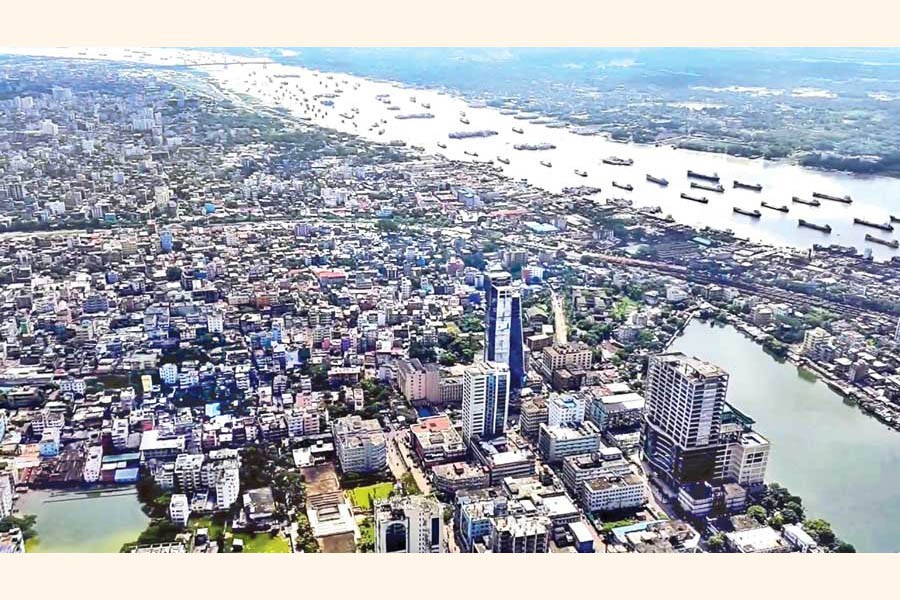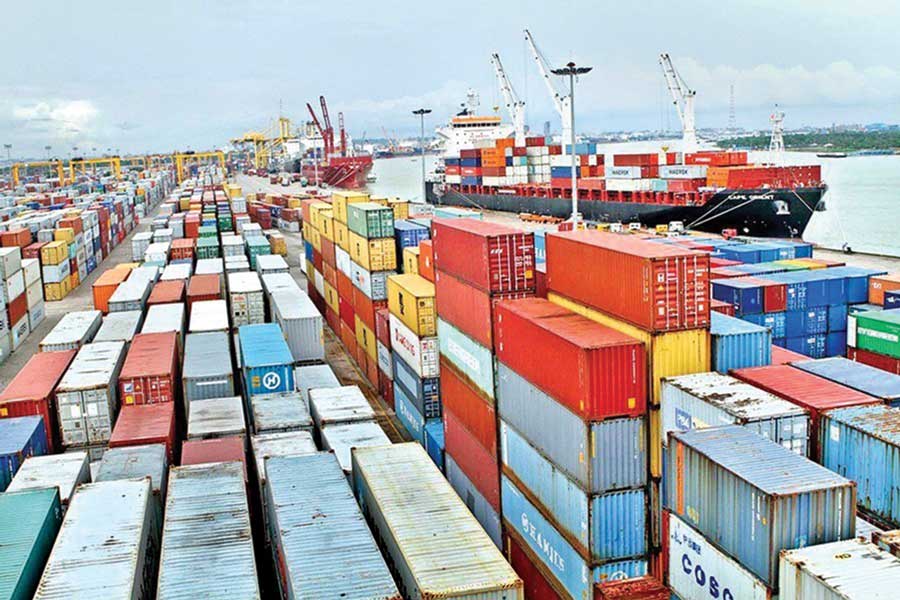 A partial aerial view of Chattogram city
A partial aerial view of Chattogram city  Chattogram is the country's second-largest city and it hosts the prime seaport. Popularly known as commercial capital, it is situated in the southeastern part of the country, on the banks of the River Karnaphuli. Much of the city is surrounded by hilly terrains. Because of hosting the country's prime seaport, Chattogram is the main route for almost all of Bangladesh's imports and exports, generating a major portion of the country's annual revenue.
Chattogram is the country's second-largest city and it hosts the prime seaport. Popularly known as commercial capital, it is situated in the southeastern part of the country, on the banks of the River Karnaphuli. Much of the city is surrounded by hilly terrains. Because of hosting the country's prime seaport, Chattogram is the main route for almost all of Bangladesh's imports and exports, generating a major portion of the country's annual revenue.
The people of the city are diverse and multi-ethnic, and the native Bangalee people have had undergone a significant influence on them from Arab, Afghan, and Mughal traders and settlers, all of whom had travelled to the city after arriving on its shores hundreds of years ago. There are many Tibeto-Burman tribes such as the Chakma people who have undergone the influence of the Bengali culture. The descendants of Portuguese settlers, known as the Firingi, also continue to live in Chattogram, as Catholic Christians, in the Old Portuguese enclave of Paterghatta. But most of the population belongs to the religion of Islam.
Major Problems
The port city Chattogram is presently experiencing a lot of problems that include water scarcity, sanitation problems, traffic congestions, waterlogging, environmental hazards, hill cutting, etc.
The Chattogram WASA is meeting only 30 per cent of the demand in the port city. So 70 per cent of the residents of the commercial city are deprived of water facilities, particularly during the summer. During the summer, the production of CWASA declines alarmingly because of persisting electricity loadshedding attributed to the fall of the water level in the Kaptai Lake that hosts a hydroelectric plant. Vast areas of the city still remain out of the network of the Chattogram WASA.
According to the Chattogram WASA, the total demand of the city is over 120 million gallons of water while the CWASA can produce about 38 million gallons of water daily. Of them, the Mohra Water Treatment Plant is producing 20 million gallons of water daily and the remaining 18 million gallons are produced by deep tube-wells. Of them, 30 per cent is wasted due to system losses reducing the actual supply of water to 26 million gallons per day.
 Surprisingly the Chattogram WASA has been running without any sewerage system since its inception in 1963. The CWASA started its activities with the supply of 16 million litres of water through 19 deep tube-wells. But since then the CWASA has been lacking the sewerage system.
Surprisingly the Chattogram WASA has been running without any sewerage system since its inception in 1963. The CWASA started its activities with the supply of 16 million litres of water through 19 deep tube-wells. But since then the CWASA has been lacking the sewerage system.
The garbage of the city that is home to 6.0 million (60 lakh) people flows into the river Karnaphuli through different canals and drains of the city due to the lack of a sewerage system. As a result, a huge quantity of sewer is directly is dropped into the drains and canals of the city polluting the environment seriously.
Environmental hazards are being caused by the ship-breaking industry. The ship-breaking industry starting in 1971 has been polluting the environment of the locality posing a serious threat to the health of the people living in nearby areas. Even two lakh workers employed in the ship-breaking industry are now working in a hazardous atmosphere at the high risk of life in handling old equipment used to scrap ships as well as some dangerous chemicals in their daily routine work.
During the scrapping of old ships, different types of poisonous chemicals including oil used in the ships are spread in the yards. These poisonous chemicals and oils spill over to the sea near the coast also causing a serious threat to maintenance of a healthy environment.
During the scrap of gas boilers of ships poisonous gas is emitted causing some diseases like cough, scabies etc. to the local people. The plants and trees of the surrounding areas are affected badly.
Water of the Bay of Bengal at the Chattogram port channel is rampantly polluted by discharging oil, waste and other chemicals from ships. Besides, water of the river Karnaphuli at the river mouth is being polluted for the same reason. The industrial units on the banks of the river discharge the poisonous chemicals and waste into the water of the Karnaphuli while the ships and tankers also discharge oil.
Hill cutting is rampant in greater Chattogram. Some dishonest people of seven categories including those having political influence, local goons and those in the administration are involved like a syndicate in the rampant hill cutting in the port city resulting in serious ecological imbalance and environmental disasters. Massive hill cutting by influential individuals or organizations, both from public and private sectors, for commercial and non-commercial purposes had been continuing and it took a serious turn in recent years in the city and district which threatens environment, natural beauty and bio-diversity of this region having a wonderful geographical uniqueness. The rampant hill cutting is the prime cause of the landslide here. The incidents of landslide occur particularly in the rainy season.
Besides, the clinical garbage also pollutes the port city, as there is no management of clinical garbage of at least 200 hospitals and clinics in Chattogram. The public health of the city is very much hampered due to throwing of clinical waste into open areas in the city, particularly in the nearby areas of the clinics and hospitals.
According to rules, the clinics and hospitals have to build their own plants to destroy their clinical waste. Despite the rules, the authorities of the clinics and hospitals could not maintain the garbage plants.
Waterlogging is one of the major problems of Chattogram. In every rainy season and even during the monsoon rain here in Chattogram people suffer from waterlogging. The sufferings of the people of Chattogram know no bounds due to the waterlogging caused by monsoon rain every year. Heavy downpour causes the waterlogging and disrupts the normal life of the people every year.
The low-lying areas of the port city go under knee-deep water following torrential rain for several hours during the monsoon. So the inhabitants of those low-lying areas remain stranded.
Prospects
However, more than 6,000 large, medium and small-scale industrial units are situated in different industrial areas of Chattogram, namely Nasirabad, Kalurghat, Patenga-Halishahar and Kumira-Sitakunda heavy industrial areas. Bangladesh Small and Cottage Industries Corporation (BSCIC) has developed four industrial estates in Chattogram that include Kalurghat BSCIC industrial estate, Fouzderhat BSCIC industrial estate, Sholashahar BSCIC industrial estate and Patiya BSCIC industrial estate.
Some 119 industrial units of the Chattogram Export Processing Zone (CEPZ) are also operating regularly. A total of 119 industrial units including 72 foreign industries, 17 joint ventures and 30 local industries are operative. A total of 100 thousand (one lakh) workers are now employed in all industrial units of the CEPZ. The export goods include garments and its accessories, textiles, terry towel, footwear and other leather goods, knitted fabrics and knitted garments, electronics and electrical goods, sportswear, plastic goods and paper products which are exported to the USA, the UK, Germany, France, Belgium, Italy, Spain, Portugal, Austria, Canada, Malaysia, China, India, Pakistan, UAE, Nepal, Australia, and Rumania. The CEPZ, the first EPZ of the country, was set up in 1983 with the aim of increasing the foreign investments in Bangladesh.
Besides the CUFL, Kafco, and TSP complex, three major fertilizer factories of the country are situated in Chattogram.
The shipbuilding industry can turn into the topmost foreign exchange earner and play the lead role in creating employment opportunities in the country with state patronisation. If it is done, the industry can alone account for more than 3.0 per cent of the Gross Domestic Products (GDP) of the country.
A large number of shipbuilding units have now been set up in the country in the private sector. Of them, one industry has attracted the attention of foreign buyers. The Western Marine Shipyard Limited in Chattogram has obtained orders for building oceangoing vessels from foreign companies.
Economy and development: The sea-borne exports consist chiefly of readymade garments, knitwear, frozen food, jute and jute goods, leather and leather goods, tea, and chemical products. There is also a large volume of trade aided by country boats, bringing chiefly cotton, rice, spices, sugar and tobacco. Chattogram is home to a large number of industries ranging from small to heavy. It has automobile industries, oil refinery, pharmaceutical plants, chemical plants, export processing zones, steel mills etc. The privately-owned Korean Export Processing Zone (KEPZ) is also located in Chattogram.
Chattogram is the site of Bangladesh's busiest port which handles 90 per cent of the country's all imports and exports. The strategic location of the port has allowed investors to contribute to development of the city. Owners of major business houses such as M.M Ispahani, A.K Khan and Co., Taher Group, Habib Group, PHP Group, KDS Group, S. Alam Group, Mostafa Group, and T.K Group are all residents of Chattogram.
On the other hand, the Mirerswari Economic Zone (MEZ) is being constructed on around 30,000 acres of land at Mirerswari in Chattogram. The MEZ has already got the investment proposal of around 10 billion US dollars. Several lakh people will be employed at the factories of MEZ after completion of the project. Already 16,000 acres of land have been acquired for the MEZ. Besides, acquisition of additional 7,000 acres is underway to establish the zone on 30,000 acres. The BEZA has also acquired 12,000 acres in Cox's
Bazar and is in the process of getting hold of another 16,000 acres.
© 2024 - All Rights with The Financial Express
